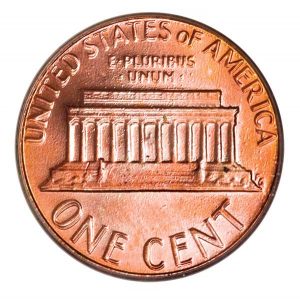1982 D Penny Value
The 7 Business Strike Varieties:
- 1982 Large Date Copper
- 1982 Large Date Copper plated Zinc
- 1982 Small Date Copper
- 1982 Small Date Copper plated Zinc
- 1982 D Large Date Copper
- 1982 D Large Date Copper plated Zinc
- 1982 D Small Date Copper plated Zinc
First and most easily, if your penny is dated 1983 or later, it is zinc. For pennies dated 1982, it could be either zinc or copper. The simplest way to tell without using machinery is to weigh your penny with a scale that reads to the tenth of a gram. A copper penny weighs 3.11 grams while a zinc penny ways 2.5 grams. 1982 Doubled Die Reverse. Fivaz Stanton Numbers: Unlisted Breen: Unlisted Coneca: DDR - 1 Crawford: CDDR-001 Wexler: WDDR-001 Coppercoins: 1982P-1DR-001.
There is also a 1982 S Large Date Copper Proof
Background
Not surprisingly, our government makes a handsome profit when it creates coins and paper
Uncle Sam pockets the rest as profits.
In the early 1980's, with the increasing costs of labor, dies, and metals, it was costing the
Unable to get Congress to approve eliminating the cent, the mint decided to make it out of the
mint officials didn't want to upset the public in any way. Thus, the metal decided upon was to
happy to get away from copper because the public tended to hoard cents when copper prices
solid copper and copper-coated zinc cents were produced in 1982 so as to discourage saving
officials, and one of the reasons why they are sometimes called before Congress to explain coin
Why did the mint Create 7 Varieties?
They didn't. The die varieties were noticed by coin collectors, and since collectors normally
way. Remember, the mint stays away from anything that causes the public to hoard coins
Identifying the 7 Varieties
The term copper, bronze and brass are all used interchangeably, but not necessarily correctly,
question.
First of all, 1982 cents can be Philadelphia mint (no mintmark) or Denver mint (D mintmark).
Secondly, 1982 cents can be a large date or a small date. One of the best ways to distinguish
Thirdly, the solid copper cents weigh approximately 3 grams, while the copper-coated zinc
Build your own Coin Scale - it's easy!!!
You can make your own scale that will differentiate between ZINC and COPPER 1982 cents. All
dated after 1982.
Place the round wooden rod under the tongue depressor as shown. You must find the
zinc dated after 1982). The rod must be place in a spot that makes the depressor go up
cents again, and draw a line at the best spot to place the cents.
Now, try some 1982 cents. The 1982 cents that make the scale go down are copper, and the
Article and Scale Design by Gabe of Gabe's Coins. Pictures by LCR
However, the grading service does not consider the coin to be a true eighth variant. The press release states, “While one could argue that this piece is the eighth variety of circulation issue 1982 cents, NGC has attributed it as a mint error since it was undoubtedly struck in error from a leftover planchet and unintentionally released into circulation. The piece weighs 3.08 grams, which is well within the Mint’s tolerance for bronze cents.”
1982 D Penny Value Copper
By classifying the coin as a Mint error, the 1982-D brass cent falls into the same category as the famous 1943 Lincoln copper cent. However, that World War II era cent, which can sell for six-figure prices, has a long history that enhances its vaunted collector status. Whether the new cent will approach the same lofty levels as the 1943 Lincoln cent will depend on collector interest and any subsequent discoveries.
Potter told Coin World on May 31 that while subsequent reports of other examples have been made, none has been verified.
Seven official variants

In 1982, the U.S. Mint famously struck cents in two compositions: the traditional 95 percent copper and 5 percent zinc, and the new and more economical copper-plated zinc. In addition, the Mint surprisingly made an obverse hub change in mid-1982 that resulted in two distinctive variants of different relief and sharpness of letters that collectors simplify as the Large Date version (standard since the hub change of 1974) and the Small Date version (the new hub).
When 1982 had ended, the four production facilities of the U.S. Mint had struck these seven circulation variants: 1982 Large Date, Brass (or Bronze); 1982 Small Date, Brass; 1982-D Large Date, Brass; 1982 Large Date, Copper-Plated Zinc; 1982 Small Date, Copper-Plated Zinc; 1982-D Large Date, Copper-Plated Zinc; and 1982-D Small Date , Copper-Plated Zinc.
It should be noted that the Philadelphia Mint, San Francisco Mint and West Point facility all struck identical 1982 cents lacking a Mint mark; the individual strikes cannot be identified by facility of origin.
1982 D Penny Value Worth
Mint officials had decided prior to 1982 that it would strike cents of both compositions concurrently rather than halt production of the 95 percent copper cents before switching to copper-plated zinc. That decision, coupled with the hub changes, gave collectors multiple pieces to seek in circulation. However, according to U.S. Mint officials, no cents were struck at the Denver Mint in the new content with the new design. That did not stop collectors from seeking an example of that eighth variant, and now, more than three decades later, one has been found.
1982 D Penny Value Youtube
Auction offering
1982 D Penny Value Coin Values
Numismatic Guaranty Corp. graded the unique coin About Uncirculated 58 and identified the piece as the “Discovery Coin” on the slab label. The coin weighs 3.08 grams, slightly below the standard of 3.11 grams but generally within tolerance levels.
The coin will be offered during the Stack’s Bowers Galleries auction at the ANA World’s Fair of Money this August in Denver.